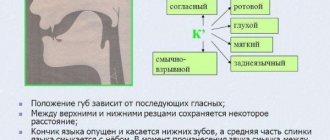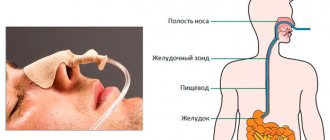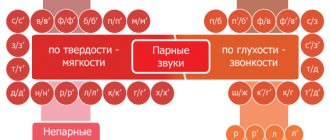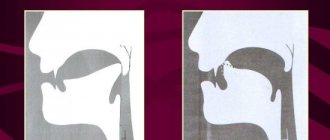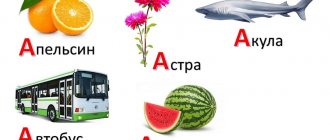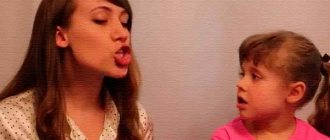Modern parents know that in order to successfully study at school, children need to clearly and clearly pronounce all the sounds of their native language. Without correct speech, it is impossible to express your thoughts, write dictations, or compose retellings. Usually, by school, a child should have well-developed speech. However, some preschoolers never learn to speak clearly and distort some sounds, so it becomes necessary to consult a speech therapist. Experts note that recently new types of dyslalia (sound pronunciation disorders) have appeared, which were almost never encountered before. These include incorrect pronunciation of the sounds T, D. Will parents be able to work on correcting sound pronunciation at home if such a speech disorder is discovered in a child? In order to properly organize classes at home, you need to understand what the production of the t sound is in connection with the production of the d sound.
Important: correct pronunciation develops mainly by the age of five, so you should seek special help after 5 years. However, from an early age it is necessary to carefully monitor the child’s speech, not to be touched by the distortion of words, but, if possible, to correct the child’s speech errors.
Features of pronunciation of sounds T D
What typical mistakes do children make when pronouncing them? Systematically occurring speech disorders include:
- Replacing the front-lingual sounds “T – D” with the corresponding back-lingual “k – g”, for example, “k( t )igrenok”, “ing( d )yuk”.
- Mixing the front-lingual consonants “T – D” with the back-lingual “k – g”: cell - cell; glass - rolled.
- The sound “T” can be softened by “P” or “K”, for example: pichka - bird; drink, drink instead of dot.
- Persistent confusion T H (u t it - teaches, nine ( h)ka), T Ts (Pet ya - Petya, blooms - blooms).
In children with speech errors, one can observe the following construction of sentences: “Mom, where (where) are my tanfettes (sweets)?”, “There are sweets on the tartine (picture). Others immediately notice such violations, and parents may also detect incorrect articulation of the sound t : instead of leaving the tip of the tongue below, resting on the front teeth, the baby raises it to the palate.
Very often the reasons for incorrect pronunciation are:
- Disturbances in articulation (function of the speech organs).
- Low mobility of the lower jaw.
- Underdevelopment of auditory perception (the baby cannot distinguish sounds).
- It’s a bad example for adults when someone around them pronounces T D .
In any case, the diagnosis is made by a speech therapist, and parents are engaged in making sounds at home in accordance with his recommendations. Articulation gymnastics is very helpful in work, which should become a constant companion not only in classes, but also in everyday life.
Important: correction of the pronunciation of sounds N T D, as a rule, is carried out after simple sounds are clearly defined in the preschooler’s speech: vowels (a, u, o, i, e, s) and consonants (b b, p p, m m, v v, f f).
To examine the pronunciation of T D , you can offer your child a small test in the form of several exercises:
- Following the adult, pronounce sentences in which these sounds occur, for example: Dusya gives melon to Dasha. Aunt Tanya has notebooks on the table.
- Look at pictures that depict objects with sounds T D , for example: slippers, calf, tiger, axe, TV, cart, cake; melon, house, door, tree, girl, children.
- Among the pictures laid out on the table, find the one that the adult names: dot - daughter, cloud - dacha, duck - pipe, pond - twig, house - volume.
Work is required for the child whose speech cannot be traced with TD or is replaced by other sounds, and there is no differentiation (distinguishing sounds that are similar in sound).
Techniques for producing sounds T D
The classic techniques of speech therapy work are the preparatory stage and sound production, which can also be actively used in home exercises. If you choose the right exercises, it will not be difficult for parents to cope with their child’s speech disorders.
Important: before teaching a child the correct articulation of the sound T ( D ), the adult must himself practice the position of the lips and tongue in front of the mirror: the lips take the position of the vowel that follows T (ta - ta - ta); the tongue is fixed in the upper teeth; the palate is raised. In addition, articulatory gymnastics must also be previously rehearsed by an adult.
Preparatory stage
Speech therapists insist that if the baby’s tongue is not strong enough to make sounds, it is necessary to first strengthen the muscles of the tongue and lips. Therefore, the preparatory stage necessarily includes articulation gymnastics. Speech therapy massage exercises will help prepare the speech apparatus for it::
- An adult, using a mirror, teaches the preschooler to take the correct position of the lips and tongue, showing the differences in pronunciation, for example, T (tip of the tongue) and K (tail of the tongue): “The cake is being eaten,” “Drops are dripping.”
- Making the T requires a sharp and strong exhalation. Therefore, it is necessary to develop the ability to exhale correctly. You can use the following exercises: “Soap bubbles”, “Balloon”, “Flying snowflakes (from a napkin or cotton balls)”.
- Then follows articulation gymnastics:
- “Wide smile” – connect your teeth, stretch your lips wide and hold this position for up to 7 seconds.
- “Tick-tock clock” - the tongue quickly moves left and right along the upper lip.
- “The tongue does not obey” - say five-five-five, tapping your upper lip on your tongue, gradually differentiating (distinguishing) the sounds P T.
- “Tongue - spatula” - relax the tongue, making it wide, place it on the relaxed lower lip.
Important: we must try to make it interesting for the child to complete rather monotonous preparatory tasks. To do this, it is necessary to introduce new articulatory gymnastics exercises, which can be borrowed from speech therapy practice, at each home lesson.
Staging sounds
How to install sound at home? Experts offer several ways to set sound; a parent can try all of them and choose the one that is more accessible and understandable to the baby.
- Setting T by imitation: an adult invites a preschool child to repeat first the syllables, and then the words; it is advisable to start with the syllable “ta”. For example: ta-ta-ta, ta-you-to-tu, you-you-you, you-ta-to-tu, to-to-to, to-tu-ta-you. Then the transition to words - pure words: ta-ta-ta, ta-ta-ta, such beauty; you-you-you, you-you-you, gave us flowers; tu-tu-tu, tu-tu-tu, we clean up; so-and-so, so-and-so, I put on my coat. A creative approach to speech activities will allow parents to independently compose similar phrases in sound, involving children in creativity.
- Interdental method: an adult shows the child the position of the tongue (the tongue is pressed between the lips, in this position you need to exhale strongly until you hear a sound, then place the tongue behind the teeth). You can teach how to control your exhalation by playing a “fence” for air by placing your palm in front of your mouth. Or arrange a game of “ball” (a cotton ball is driven into an improvised goal with a stream of air).
- Speech therapists use the method of setting T from the sound P. The child repeats pa-pa-pa, placing the wide tip of the tongue on the lower lip, then, smiling broadly, pronounces P , resulting in T.
- When setting D , the work is identical, only when exhaling the voice is added.
Automation of sounds T D
When the sounds T D are delivered (correct articulation has appeared) and the child learns to pronounce them, the next stage begins - automation (practice of the skill). It is important to achieve fluent pronunciation here. Since this is new for a preschooler, it means a lot of training is required. Speech therapists recommend introducing the practiced skill gradually: first through syllables, then words, then sentences. Articulation exercises, games based on poetry, stories, riddles will help well in this work, which will also maintain interest in the classes. At the same time, do not forget that every home lesson must begin with articulatory gymnastics.
Important: parents need to make every effort to ensure that the incorrect pronunciation of T D disappears from the child’s speech as quickly as possible. It should be taken into account that new material is introduced only after the previous one has been mastered.
What can an adult do to keep the child interested in activities and at the same time repeat monotonous actions over and over again? Gaming techniques will help, with the help of which syllables are practiced, for example: ta-ta-ta, yes-da-da, to-to, do-do-do, ta-you-to-tu, at-at-at, yes-dy-du, yt-yt-yt, ud-ud-ud. Plots can be very diverse:
- Let's teach the doll to brush its teeth, show it what articulation gymnastics is: “let's brush the teeth” (various movements of the tongue on the teeth from the outside and inside, up and down, left and right).
- Let's sing a song to the toys: “tra-ta-ta, tra-ta-ta, we are taking a cat with us”;
- Play the drum for the bear: tram-ta-ta-tam; on a dog pipe: doo-doo-doo.
- I start speaking, and you finish (the adult pronounces part of the word, which must end in a syllable with the sounds T D ): flowers, beauty, candy, mast, coat, bouquet; bicycles, sneakers, beards.
- Hello, little finger! (the thumb is put forward, and each finger in turn “greets it” with the syllables: ta, to, tu, you; yes, do, du, dy).
After the preschooler has automated sounds, the work becomes more complicated, the pronunciation of sounds is fixed in words.
Exercise “Collecting beads”
An effective exercise on automating the sound T with older preschoolers. An adult invites the preschooler to collect unusual beads, having previously agreed which syllable should follow which. For example, there may be such a sequence: that - that - you - that - that - that. Work with the sound d is carried out in a similar way. At first, you can rely on visual aids (colored beads, circles of colored paper, pencils). Subsequently, the visualization is removed, and the child acts from memory.
Exercise “Come up with words with the sounds T D”
Invite the child to repeat after the adult words with the sounds T D at the beginning, middle, and end of the word. For example, an adult starts with a more understandable syllable ta : ta kidneys, ta chka, ta reel; The baby continues: ta NK, ta Buret, ta Nets, ta Xi. Then he moves to another position T D : cat , cock , roll , leaf ; sala t , play t , collect t , bark t , help t . Or daughter , yes , day , gifts , soldier ( voice emphasis on the highlighted one). If at first it is difficult for a preschooler to continue his vocabulary, you can work with pictures. The work with the syllables you dy : you qua, hole , you , dy m; then to : then por, then mouth, then thick, kind , then chka, dochka ; tu du : tu chka, tu loop, ra du ga, du ga. It is better to prepare the vocabulary in advance. An even more interesting automation exercise will take place with a ball. The adult throws the ball to the child with his word, the child responds with his own.
Exercise “Sound t and sound d in a sentence”
Similar work is done with sentences; the preschooler repeats after the adult, emphasizing T D :
- Tanya and Tom are traveling on a tram.
- Trofim is riding in a taxi.
- The plane is flying.
- Aunt Tonya is planting flowers.
- Dima and Tolya are skating on the skating rink.
- Dasha and Denis shared the melon.
- Children go to kindergarten.
In order for a preschooler to be able to independently compose a sentence, plot pictures are used. It is necessary to ensure that all words of the sentence have a sound that is automated ( T D ).
Nursery rhymes, pure sayings for automating sounds etc.
To make it easy for parents to choose an artistic series for practicing the sounds of T D, you can use speech therapy selections or come up with pure sounding phrases together with your children. For example, the parent starts with syllables, and the child then rhymes the sentence:
- Ta-ta-ta, ta-ta-ta, (they saw a whale in the sea ) .
- Tu - tu - tu, tu - tu - tu, (let's pour some milk into it ).
- Yes - yes - yes, yes - yes - yes, (splashed all over with water ) .
- water in the glass ).
- Yes - yes - yes, yes - yes - yes, (don't go there ) .
- doo , (go there anyway ).
A lot of nursery rhymes can be found on children's websites or in children's books. Their main task is to automate the sound T ( D ), its correct pronunciation, for example:
Shadow, Shadow, Shadow, above the city there is a fence. The animals sat on the fence and boasted all day long. The fox boasted: I am beautiful to the whole world! The bunny boasted: Go, catch up!
Pull the canvases, the canvases are simple. Pull, Pull, Pull, Across, across.
We know, we know: Yes-Yes-Yes! Water is hiding in the tap! Come out, water! We came to wash up!
LaDushki, LaDushki, Let's bake pancakes. We'll put it on the window. Let's leave it to cool. Let's wait a little, Let's give pancakes to everyone.
Differentiation of sounds D T
An important stage in speech therapy work is the differentiation of sounds (distinguishing similar sounds, T D, D D, T T). This stage is carried out in parallel with automation and is necessary in order to compare sounds (soft and hard) and practice pronunciation. You can teach a preschooler new special techniques for distinguishing sounds: a hand is applied to the throat while sounding, the sound is determined ( D - voiced, voiced; T - deaf, without a voice). For differentiation, you can use already known techniques: syllables, words, sentences in exercises, games, sayings, nursery rhymes.
Differentiation of sounds T ТТ in the exercise “Compare sounds in guesses”
An adult asks the child to guess riddles, and then asks if the sound of T in all the riddles? The main thing is to make it possible to understand the difference in the pronunciation of the sounds T (hard) T (soft).
Round, not a month, yellow, not butter, Sweet, not sugar, with a tail, not a mouse ( you kwa).
He bows, bows, when he comes home he will stretch out ( then ).
A block froze over the water, and she dreams of fish for lunch. There are fins and too lazy to swim, the fish will be eaten by another ( seal laziness).
Exercise “Correct phrasing”
The goal is to teach how to pronounce and distinguish DY .
Grandfather Dodon played the pipe, Grandfather hit Danka with the pipe.
A woodpecker is chiseling a tree, Day after day crushes the bark.
Game "Come up with a proposal"
To establish and consolidate the pronunciation of T D , adults can teach children to come up with beautiful sentences while relying on verbal helpers. Then determine which words have hard T D and which have soft Т Дь:
Denis - telephone (Denis was given a telephone); Home is a cat (Our cat doesn’t walk, he’s at home); Tanya - melon (Tanya loves melon); Tyoma is a pipe (Tyoma learns to play the pipe); Dusya - pictures (Dusya loves to look at pictures);
Important: parents should understand that home exercises for correct pronunciation consist of developing the skill of pronouncing the sounds of their native language. This process is long, systematic, and requires patience and persistent training in automation and sound differentiation. A thoughtful selection of articulatory gymnastics, exercises, games, and verbal material will help to achieve good results in the development of competent, beautiful speech in preschool children.
Etc.
Graphic abbreviations adopted in the Russian language are numerous and varied. Graphic abbreviations are used in scientific and popular science literature, in dictionaries and bibliographic lists, in cartography and in private correspondence. Students of the Russian language will encounter abbreviated words both when reading textbooks, newspapers, notes and letters, and on the street, in an office, in transport and at the stadium.
Even a trained native speaker cannot always decipher this or that abbreviation that he comes across, so the attention of Russian language learners should be paid to abbreviations that have practical, communicative significance and are used every day and everywhere. These graphic abbreviations include:
1.
Designations of grammatical categories and concepts in textbooks and dictionaries:
m.r.
(masculine),
units.
h. (singular),
pr. v.
(past tense)
2nd l.
(second person),
ch.
(verb),
noun
(noun),
suff.
(suffix) ...
2.
Designations of units of measurement (without affecting terminology and accepted abbreviations in specialized and scientific literature):
- Weights: g
(gram),
kg
(kilogram); - Time: min
(minute),
h
(hour),
g
(year); - Pressure: mm.
rt. Art. (millimeters of mercury),
atm.
(atmosphere); - Distances, areas, volumes: km
(kilometer),
ha
(hectare),
l
(liter); - Information: b
(byte),
GB
(gigabyte); - Coordinates: s.
w. (north latitude),
c.
d. (eastern longitude); - Quantities: thousand
(thousand),
million
(million),
billion
(billion),
units.
(unit);
3.
Names of monetary units:
r., rub
.
(ruble), dollars
(dollar),
shek.
(shekel),
y.
e. (conventional unit)
4.
Toponymic designations on maps and diagrams:
st.
(street),
pl.
(area),
st.
m. (metro station),
ave.
(prospect),
r.
(river),
city
(city, mountain)
5.
Common abbreviations designed to save time and space and speed up writing:
so-called
- so-called;
i.e.
– that is;
since
- since;
That.
- Thus;
see
- look;
page
– page;
BC
e. - BC;
railway
– railway;
used
– used;
And.
O. – acting;
and others
- and others;
people
- a person,
and
so
on
, and
so
on .
There are rules and standards governing the spelling of graphic abbreviations, the presence or absence of periods, commas, spaces in the abbreviation used, and the addition of endings to numerals. It seems appropriate to invite students to study these rules as the need arises.
